Saturday, September 4, 2010
Rare White Lion Cubs Debut
Tuesday, August 10, 2010
Polistes dominula
Nests are begun by overwintered founding queens or foundresses , who spend about a month in the spring constructing a nest and provisioning offspring, the first of which will become daughter workers in the growing colony. Males are produced later, and when they start to appear, a few daughters may mate and leave their nest, to become foundresses the next season. The switch from production of workers to production of future foundresses is not utterly abrupt, therefore, as has been considered the case for other species of Polistes. The colony disperses in the late summer, with only males and future foundresses produced instead of workers, and individuals frequently cluster in groups to overwinter. Hibernation does not usually take place on former nest sites.
The colony disperses in the late summer, with only males and future foundresses produced instead of workers, and individuals frequently cluster in groups to overwinter. Hibernation does not usually take place on former nest sites.
Sunday, August 8, 2010
Reverse Vasectomy for Rare Horse
Thursday, August 5, 2010
Rare White’s Tree Frogs
A normal 10 cm (4 inches) in length, this frog tends to look in fat and flabby. Females have been known to produce as long as 5 inches, nose to vent. The males usually grow to be about 4 inches long. Its' smooth green skin characteristically appears to be folded from its' tendency to be obese.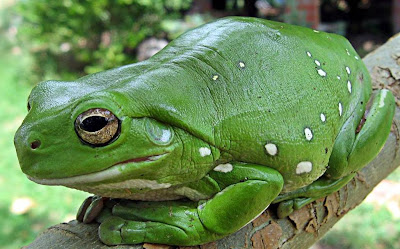 Occasionally it will change colors to brown, and sometimes it will also have some little white spots all over it's body. Their tough skin helps them to retain water. It seems, from what other White's Tree Frog owners have said, that the higher the humidity, and lesser the temperature, the darker and browner their colors. Whereas if the temperater is higher, with less humidity, they tend to be brighter, more blue. It's funny looks have also brought about nicknames like "Dumpy Tree Frog" and "Smiling Frog."
Occasionally it will change colors to brown, and sometimes it will also have some little white spots all over it's body. Their tough skin helps them to retain water. It seems, from what other White's Tree Frog owners have said, that the higher the humidity, and lesser the temperature, the darker and browner their colors. Whereas if the temperater is higher, with less humidity, they tend to be brighter, more blue. It's funny looks have also brought about nicknames like "Dumpy Tree Frog" and "Smiling Frog."
Saturday, July 31, 2010
Rare asian golden cat
The Asian Golden Cat, also called the Asiatic Golden Cat and Temminck's Golden Cat, is a medium sized wild cat weighing from 12 to 16 kilograms. In captivity this type can live up to 20 years, but its average lifespan in the wild is likely far shorter. While the fur is mostly foxy red or golden brown, black or grey color variants may also be found. Usually, the coat is plain, save for some spots on the underside, and sometimes very faint spotting on the rest of the coat. However, in China there is a color variant with leopard-like spots, which resemble a Leopard Cat. This spotted fur is a recessive characteristic, i.e. when a spotted and a plain cat interbreed, the young get plain hair. Asian Golden Cat lives throughout Southeast Asia, ranging from Tibet and Nepal to Southern China, India, and Sumatra. It prefers forest habitats interspersed with rocky area, and is found in deciduous, subtropical evergreen, and tropical rainforests. The Asian Golden Cat is irregularly found in more open terrain. It ranges from the lowlands to altitude of up to 3000 meters in the Himalayas.
Asian Golden Cat lives throughout Southeast Asia, ranging from Tibet and Nepal to Southern China, India, and Sumatra. It prefers forest habitats interspersed with rocky area, and is found in deciduous, subtropical evergreen, and tropical rainforests. The Asian Golden Cat is irregularly found in more open terrain. It ranges from the lowlands to altitude of up to 3000 meters in the Himalayas.
Not a great deal is known about this rather elusive predator, and most of what is known about it has been found out in captivity. Previous observations suggested that it is primarily nocturnal, but a recent study on 2 golden cats showed arrythmic activity patterns. It is thought to be primarily solitary.
Asian Golden Cat prefers to hunt on the ground, but does climb when it needs to. When hunting, it uses a stalk and rush method typical of felines. It is known to hunt birds, lizards, rodents, other small mammals, and the occasional small or young deer, and seems to be fairly flexible in its diet. Asian Golden Cat has been reported to hunt in pairs when pursuing better animals. In captivity, it plucks the feathers of larger birds before eating them. There has been news of the Asian Golden Cat scavenging, a behavior not commonly seen in felines. Rarely, it hunts near human settlement or prey on farm animals.
Everything known about Asian Golden Cat reproduction has been figure out from comments of them in captivity. It becomes sexually mature at anywhere from 18 to 24 months of age. Its development period lasts about 80 days; litters usually consist of only one kitten. Kittens are born in the hollows of trees, rock crevices, and possibly in hollows and other protected places on the ground. The pelts of kittens are thicker and slightly darker, but with the pattern they will keep for their entire life. Based on what has been seen in captivity, it is thought that males take an active role in rearing the young.
Tuesday, July 20, 2010
Amazing Animals in Tiger Splash at Out of Africa Wildlife Park
Thursday, July 15, 2010
Alligator
Alligators are native to only two countries United States and China. American Alligators are establish in the subtropical southeast US, all of Florida & Louisiana; Alabama & Mississippi; the southern parts of Georgia, coastal South & North Carolina; Southeastern Texas & extreme southeastern Oklahoma and Arkansas. The majority of American Alligators inhabit Florida & Louisiana, with over a million alligators in every state.
American Alligators live in freshwater environment, such as ponds, marshes, rivers, lakes, wetlands, and swamps, as well as salty environments.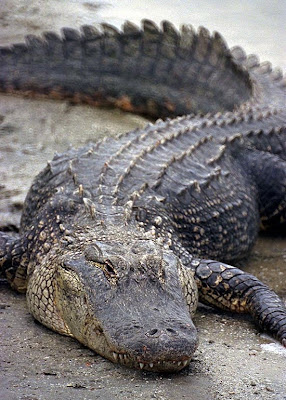 The Chinese alligator at present is establish only in the Yangtze River valley and very endangered, with only a couple dozen supposed to be left in the wild. Really, far more Chinese alligators live in zoos about the world than can be found in the wild. For example, Rockefeller Wildlife Refuge in southern Louisiana has several in captivity in an effort to preserve the species. Miami-Dade County Zoo in Miami, FL has a breeding pair also.
The Chinese alligator at present is establish only in the Yangtze River valley and very endangered, with only a couple dozen supposed to be left in the wild. Really, far more Chinese alligators live in zoos about the world than can be found in the wild. For example, Rockefeller Wildlife Refuge in southern Louisiana has several in captivity in an effort to preserve the species. Miami-Dade County Zoo in Miami, FL has a breeding pair also.
An alligator is a crocodilian in the type Alligator of the family Alligatoridae. The name alligator is an anglicized form of the Spanish el lagarto (the lizard), the name by which early Spanish explorers & settlers in Florida called the alligator.
There are 2 living alligator species: the American Alligator and the Chinese Alligator. Alligators are characterized by a wider nose than crocodiles. Both living type also tend to be dark in color, often almost black but color is very dependent on the water.
Algae-laden waters create greener alligators; alligators from waters with a lot of tannic acid from suspended trees are often darker Also, in alligators only the upper teeth can be seen with the jaws closed, in contrast to true crocodiles, in which upper and lower teeth can be seen.
Though, many persons bear jaw deformities which complicate this means of identification. An average American alligator's weight and length is 360 kg and 4 m long. According to the Everglades National Park website.
The largest alligator still recorded in Florida was 17 feet 5 inches long 5.3 m, though according to the Florida Fish and Wildlife protection Commission web site the Florida state record for length is a 14 foot 5/8 inch male from Lake Monroe in Seminole County.
The Florida record for weight is a 1,043 pound male from Orange Lake in Alachua County. The largest alligator still recorded in Alabama measured 12 feet 3.7 m. The largest alligator ever recorded calculated 19 feet 5.8 m and was found on Marsh Island, Louisiana. Few of the giant specimens were weighed, but the larger ones could have exceeded a ton in weight. The Chinese Alligator is smaller, rarely exceeding 2 m in length.
Monday, July 12, 2010
China rare earth sell abroad cut won’t last
Since everybody who follows the rare earth metals manufacturing know, the sector is conquered by export from China. So a report over the weekend that China plans to cut rare earth sell abroad quotas by 72% is a serious issue for countries that need the supply.
Or maybe not. Canaccord Genuity analyst Yuri Lynk wrote in a note that he believes the Chinese government will revoke the export quotas, as the reply from worldwide markets "will be severe."
"There have been similar incidences in the new past when China has controlled outputs and exports of rare earths, but the decisions were subsequently reversed," he noted.
Mr. Lynk covers rare earth processor Neo Material Technologies Inc. He wrote that if these sell abroad quota hold up, sales from the company's recital Materials business outside China would be "somewhat impacted." But its Magnequench division, which produces powder for magnets, could profit from an oversupply of rare earths in China, as its input costs in the nation would reduce. He maintained a "buy" rating on the stock and a price target of $5.50 a share.
Thousands watch South Pacific solar eclipse
Tuesday, July 6, 2010
Rare nimbus of the Sun Seen within Calcutta
 A rare fact was marked in Calcutta on Monday 5th July 2010, called the 22 degree round nimbus of the sun. This is seen as a red & blue ring nearby the sun and is caused by the deflection from side to side ice crystals from cirrus smoke. The cirrus smokes is formed at a height of between 5 and 10 km from the surface of the earth and are caused when water vapour freezes, making the hexagonal shaped ice particles.
A rare fact was marked in Calcutta on Monday 5th July 2010, called the 22 degree round nimbus of the sun. This is seen as a red & blue ring nearby the sun and is caused by the deflection from side to side ice crystals from cirrus smoke. The cirrus smokes is formed at a height of between 5 and 10 km from the surface of the earth and are caused when water vapour freezes, making the hexagonal shaped ice particles.
The halo phenomenon was seen between 10:30 and 11:30 am without any forecast, as this is amazing that is not possible to predict, according to Debiprosad Duari, the research and academic director of MP Birla Planetarium. The last occurrence of the 22 degree halo was in September 2008 and viewed in Siliguri.
This rare presentation of the 22 degree circular halo of the sun keyed up all who saw it and one amateur astronomer, operational as a railroad employee, called up his family and 10 year old son to go outside and have a look at how beautiful it was.
Monday, July 5, 2010
Tornadoes, Lightning in Rare Video
Wednesday, June 30, 2010
Very rare photos (Frozen Niagara Falls)
This image is displayed on the Niagara Falls Public Library website with the title "American Falls Frozen over with People on the Ice". According to information associated the image, it began circulating on the Internet in 2003 but the original source and date is not known.
The image is also featured on Niagara Falls live.com, and its position in the text suggest that it may be future to show an event in 1848 when the river really stopped flowing completely for a few hours due to an ice jam upstream. Though, it is unclear if the image depicts the actual event describe, or is only used as a general illustration of an ice bridge. This image was apparently derived from an original color postcard titled "Cave of the Winds in Winter Niagara Falls" which was mailed in August 1911. Accurately when the image was created is unclear. The image is also featured on the website of Ellis House, a Bed and Breakfast at Niagara Falls.
This image was apparently derived from an original color postcard titled "Cave of the Winds in Winter Niagara Falls" which was mailed in August 1911. Accurately when the image was created is unclear. The image is also featured on the website of Ellis House, a Bed and Breakfast at Niagara Falls.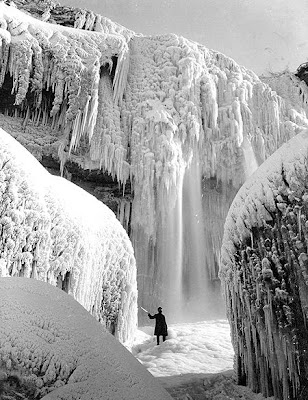 This image seems to be a cropped version, of a photograph titled "American Falls frozen over" that was taken in 1936. Comments with the uncropped image explain "The miraculous result of a cold winter, the American Falls totally froze in 1936. Notice the tiny human forms at the base of the Falls giving an idea of the density of the ice."
This image seems to be a cropped version, of a photograph titled "American Falls frozen over" that was taken in 1936. Comments with the uncropped image explain "The miraculous result of a cold winter, the American Falls totally froze in 1936. Notice the tiny human forms at the base of the Falls giving an idea of the density of the ice."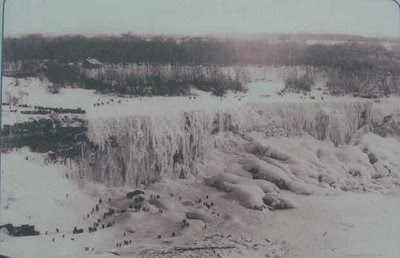 This image is also included on the Niagara Falls Public Library as well as titled "Great mass of frozen spray and ice-bound American Falls Niagara", by a date of 1902. It originally formed part of a stereo image, a popular medium at the time.
This image is also included on the Niagara Falls Public Library as well as titled "Great mass of frozen spray and ice-bound American Falls Niagara", by a date of 1902. It originally formed part of a stereo image, a popular medium at the time.
Saturday, June 26, 2010
Bush Dog (Rare animal)
The Bush Dog is a canid found in Central and South America, including Panama, Colombia, Venezuela, Bolivia, Peru, Ecuador, the Guianas, Paraguay, northeast Argentina, and Brazil. In spite of its extensive range, it is very rare; it was originally discovered as fossils in Brazilian caves and thought to be extinct. It is the only living species in its genus, Speothos.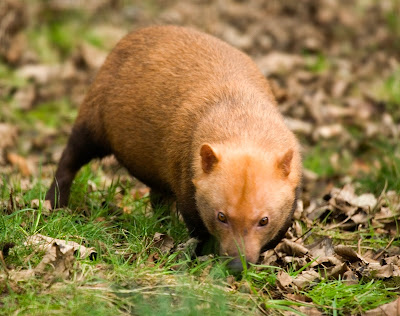 In Brazil it is called cachorro-vinagre or cachorro-do-mato. In Spanish-speaking countries it is called perro vinagre, zorro vinagre, perro de agua or perro de monte.
In Brazil it is called cachorro-vinagre or cachorro-do-mato. In Spanish-speaking countries it is called perro vinagre, zorro vinagre, perro de agua or perro de monte.
The Bush Dog has soft long brownish-tan fur, with a lighter reddish tinge on the head, neck and back and a bushy tail, while the underside is dark, sometimes with a lighter throat patch. Adults typically have 55–75 cm (22–30 in) of head and body, plus 13 cm (5 in) of tail, and weigh 5–7 kg (11–15 lb). Legs and snout are short relative to body length: the typical height is only 25–30 cm (10–12 in). The teeth are adapted for its carnivorous habits, and uniquely for an American canid, the dental formula is for a total of 40 teeth. The Bush Dog is one of three canid species with trenchant heel dentition, a unicuspid talonid on the lower carnassial molar that increases the cutting blade length.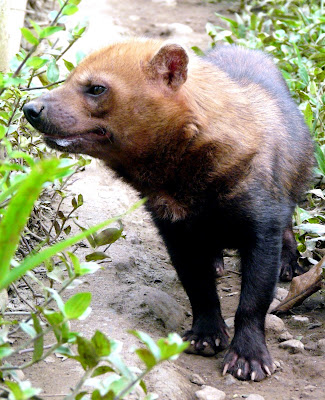 It is a carnivore and hunts during the day, preferably in wet savannahs and tropical and equatorial forests. Its typical prey is the Paca, a large rodent. Although it can hunt alone on occasion, the Bush Dog is usually found in small packs of up to 10–12 individuals, which can bring down much larger prey. It may be the most gregarious of the South American canid species. Bush Dogs have skin growing between their toes, which allow them to swim more efficiently. It uses hollow logs and cavities for shelter. Pack-mates keep in contact with frequent whines, perhaps because visibility is poor in the undergrowth where the animal typically hunts.
It is a carnivore and hunts during the day, preferably in wet savannahs and tropical and equatorial forests. Its typical prey is the Paca, a large rodent. Although it can hunt alone on occasion, the Bush Dog is usually found in small packs of up to 10–12 individuals, which can bring down much larger prey. It may be the most gregarious of the South American canid species. Bush Dogs have skin growing between their toes, which allow them to swim more efficiently. It uses hollow logs and cavities for shelter. Pack-mates keep in contact with frequent whines, perhaps because visibility is poor in the undergrowth where the animal typically hunts.
The gestation period is 63 days, and a litter can have up to six dark grey pups. Lactation lasts approximately 8 weeks. The Bush Dog is sexually mature at 1 year and lives for about 10 years.
Thursday, June 24, 2010
Legendary Or Rare Animals
Wednesday, June 23, 2010
Rare Baiji Dolphin information
The Baiji was a freshwater dolphin establish only in the Yangtze River in China. Nickname "Goddess of the Yangtze" in China, the dolphin was too called Chinese River Dolphin, Yangtze River Dolphin, Yangtze Dolphin and Whitefin Dolphin.
The Baiji River Dolphin has a thickset body and a long, thin snout, which is not fairly flat and tilt up slightly. Their pectoral fins are small and curved at the tip. A baiji's low triangular dorsal fin is established toward the center of its body.
Baiji Dolphin
Their caudal fin has a middle notch, and is well developed. Their eyes be small and are close to the top of the head.
Tiny ear opening are establish where most other dolphin's eyes are. The Baiji's colors are light, smoked gray, as well as white on the stomach. There is a white collar drawn about the eyes. Inside the lips there are 31 to 36 coned shaped teeth on every jaw.